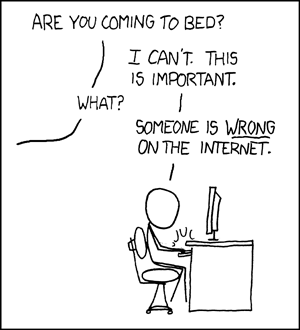The Awesome Power of Self-Deprecation in ContentOps
I promise you that I’m going to make some grammar mistakes and maybe even factual errors in this post. Well, promise might be strong. But it’s quite likely at least.
The reason, dear reader, is that I simply don’t care enough to remedy that ostensibly bad situation. That, and the fact that I read at a 5th-grade level on a good day, combine to deliver you a wholly and unapologetically unpolished experience, should you read on.
 The Inline Self-Deprecation Example
The Inline Self-Deprecation Example
Real quick, let’s go meta.
What I just did there is something that I do all the time when writing, and I do it reflexively, without really thinking. I self-deprecate because it’s kind of fun, and come on, we shouldn’t really take ourselves too seriously. But beyond that, what I did actually serves a pretty significant purpose from an operations and efficiency perspective.
I neatly eliminated the need for at least one quality assurance step (and some person-hours) in my content production.
To wit, it’s now not super important that I have an editor take a grammar pass through this, nor that I find some flavor of SME to fact check. Why would I bother? I’ve already inoculated against the critique of “but you did a bad grammar!” and against the critique of “that is factually incorrect, sir!”
Imagine how stupid one of those comments would look in the comments section when I not only hinted at, but practically promised, those outcomes.
I didn’t need to pay an editor, and I didn’t need to pay a QA SME. I just needed to explain that I don’t care enough about those things to spend that time and money.

Generalizing to B2B Content Ops
Before I go on, I want to be clear that I’m not advocating that B2B content operations adopt this exact approach and preface every piece of content with, “I don’t care if there are grammar mistakes and I’m an idiot, but, anyway, read about our recent rebrand!” I have a readership, an established style, and a certain voice. So I can get away with this specific tactic for reasons that are probably beyond the scope of this post.
What I was doing to this point is creating a vivid example of self-deprecation and the power that it can have on managing reader expectations. For the rest of the post, I’m going to lay out some tactics that you can use in B2B contexts to achieve the same outcome: minimizing spend on (often futile) quality assurance gates and un-bottlenecking your content production.
Understand that what I’m advocating for isn’t laziness, but cost savings and efficiency. Every reviewer you add to a content ops process dramatically slows down content production, increases staffing costs and has diminishing, if not negative, returns. And the famous “duty calls” XKCD reviewer (let’s call him Simon Cowell, or Simon, for short) is not who you want to optimize your spend for.

So the question you really want to answer is:
How do we comfortably produce content with minimal gatekeeping, fear-based steps?
The rest of this post is a series of tactics to help answer that question, and that are perfectly viable in B2B scenarios. I’m going to organize them loosely from least to most exotic, in terms of the optics among your peers.
1. Establish a “Notes from the Field” Tone
First off, let me briefly caveat that when I talk about tactics, like “establish a tone,” I’m talking about the particular corner of the site you own. So if you are responsible for your company’s “learn” portion of the site, I’m talking about establishing a tone for that portion of the site.
Therefore, in this first case, I’m talking about establishing a “notes from the field” tone for, say, “blog” or “learn.”
Tonally, this means that you essentially adopt the mindset of a journalist or someone live blogging an event. That doesn’t mean unprofessional or unpolished, exactly, but rather that you are going to err on the side of shipping quickly, since you want to get information out in a timely fashion. You can even caveat it with a footer or side gutter note along the lines of:
“Think of [section] as our lab notebook: informal, evolving, and occasionally messy — but always authentic.”
Setting that tone abstractly or literally, with a caveat, neatly defangs nitpickers both internally and externally. Poor Simon can join his partner in bed.
2. “If you Find Errors in this Post, Please Let Us Know”
In a similar vein, you can simply include an italicized note at the top or bottom of each post inviting readers to submit errata. Like the last tactic, this establishes a disclaimer that there may be errors, but rather than the shruggy guy as your response, you’re deputizing critics as contributors.
There is some subtlety here to note.
First of all, if you’re going to do this you need to enable comments or a submission form on the content itself. If you can’t or won’t do that, you should position the caveat in your distribution channel rather than on the site itself. It’d be a disingenuous look to invite critique while providing no means to actually do so.
And beyond that, you need to understand that if you invite this and you start to get traffic, you’re going to receive plenty of errata. You’re inviting Simon to tell you everything that’s wrong with your content, and that’s kind of Simon’s specialty. This can actually be a great way to drive engagement, but it’s also extremely labor-intensive because Simon will sour on you in a hurry if his notes go unheeded.
 3. Establish a Jokey, Not-Totally-Serious Tone
3. Establish a Jokey, Not-Totally-Serious Tone
Now we arrive at the thing that I’m doing. You too can do it, dear reader! Er, well, kinda. Probably.
This is a solid tactic, but it also has some subtleties to navigate.
First and foremost, it’s much easier for a solo creator to establish a jokey tone (e.g. me in my column on this and other sites) than it is for a group to agree on this tone. In other words, agreeing on and executing a group sense of humor is going to be pretty tough. So this tactic becomes less and less feasible with each content contributor to the site.
And I’d generally advise you not to try to somehow standardize humor, sarcasm, jokester-ism, and self-deprecation. You’ll wind up looking like someone wearing an “It’s Wine-O-Clock” T-shirt to advertise, “tee-hee, I’m silly and a little naughty, please believe me about that.”
The other issue to contend with is that, unlike the rest of this advice, you can’t really disclaim this one. I mean, I guess you could try to have a note that said something like “we don’t take ourselves too seriously,” but I’m having trouble picturing that coming off as anything other than weird and try-hard.
With this tactic, you’re going to have to put in the work to actually establish that through tone of content and rapport with the readership. And that is, legitimately, a good bit of work. I’ve achieved this myself, through the not-low-low effort path of 15 years of blogging and thousands of published posts.
4. Brand Firewall through Guest and Community Bylines
Let’s switch gears a little now and look at a different interpretation of self-deprecation. Rather than commentary on the content itself, we can look at who is writing the content.
Now I want to be clear that I’m not saying that an external contributor is somehow inferior to someone in your organization. What I am saying is that enlisting outside contributions and being quite public about it is an instant trigger for everyone to get a lot less precious about the content.
If everything you publish on your site has the generic site byline or, worse from a review perspective, an executive’s byline, you’re presenting everything you publish as representative of the company and its execs. Not only does this position every Simon critique on reddit as an assault not on the content, but the company itself, but it also invites performative content nonsense and thus highly inefficient content production. Every piece becomes a master’s thesis to defend.
You can generally avoid this issue by diversifying the bylines to various staff members, thus providing the theoretical optical escape hatch of the brand saying “well, that was just Bill the intern, and Bill’s views do not reflect our brand’s.” And you don’t necessarily need to get into the dirty business of throwing employees under the bus — the reader will infer this to some degree.
But you can make that degree “very high” if you want, by casting a much wider contribution net. Stand up a “write for us” page and slap a guest byline on contributor articles. You can then have disclaimers on that page or on the content itself saying something along the lines of
“This is a guest article from Simon Cowell. We love to provide a platform for contributors of all backgrounds and experience levels to share their tips and opinions, so please write for us (linked) if you’re interested in contributing yourself.”
This is a nice message and a nice policy. It’s also a very effective way to say “our brand didn’t directly produce this particular piece of content and contributor opinions and errata are their own.”
5. Stand Up a Property or Microsite
 The last tactic I’ll mention is likely the hardest to sell. In my experience, it simply doesn’t compute for a lot of people, even though I personally think way more people should take advantage of it.
The last tactic I’ll mention is likely the hardest to sell. In my experience, it simply doesn’t compute for a lot of people, even though I personally think way more people should take advantage of it.
I’m talking about establishing a secondary, community website that isn’t directly associated with your brand. For instance, Hit Subscribe owns a community site and content lab called “Make Me a Programmer.” (It’s actually the site we use in our public demo of Osiris).
On that site, we can publish whatever we want, without concern about brand perception. As an example, I ChatGPT-ed up some blog posts verbatim on that site, simply to see how they would perform in search compared to human-written posts. I… probably wouldn’t have done that on this site. Simon would have really let me have it, jeopardizing my long-standing policy of completely ignoring any Simons I encounter.
When B2B brands do this, it tends to take one of two formats:
- Microsite like makemeaprogrammer.
- Media sites like TechBeacon, back when it was owned by Hewlett Packard.
In either case, the owning brand typically presents itself as a top-level sponsor of the subsidiary, thus creating an even larger moat/firewall for the brand than simply disclaiming guest contributors. The reason I like this play so much is that you can instrument the property with analytics, marketing automation, and CTAs to your heart’s content. So you actually wind up losing very little in terms of your ability to qualify leads, less of course the diluted domain authority and cross-domain jumping for CTAs.
That said, in my experience this downside is typically an order of magnitude less than the downside of fretting over content until you simply don’t produce any, and all of the content people get RIF-ed (which happens a lot). Or from a less personnel and human perspective, it’s simply better business to produce content at 80% effectiveness and 100% efficiency than 100% effectiveness and 5% efficiency.

The Likely Impact and Benefit
Given that volume channels look like hockey sticks (ala compounding interest), delay matters. A lot. And you can assume that each reviewer adds a roughly exponential-flavored delay, meaning production, post-draft, per reviewer will look, at scale, something like this:
- 0 Reviewers: 0 time
- 1 Reviewer: a few days
- 2 Reviewers: 1-2 weeks
- 3 Reviewers: 3-4 weeks
Exponential-ish delay as a draft factor on an (initially) exponential-ish channel is a disaster. Each of these reviewers, years out, will likely cost you hundreds of thousands of visits and hundreds of qualified lead visitors. That’s a massive cost.
Now the fact that it’s a massive cost doesn’t, ipso facto, mean it isn’t worth it. You might want this type of review on the occasional piece of high leverage content or, theoretically even at scale in certain instances, like high ticket (7+ figure) services. What it does mean is that you should go into it very skeptically and look for all possible alternatives to avoid incurring this cost.
What I’ve presented here is an array of such alternatives, and I hope you find some of them useful. And I hope you get your leads (and sanity) back.
Or not. Whatever, what do I know? I’m just some dope that probably forgot an Oxford comma in this post, so caveat emptor.
Interested in More Content Like This?
I’m Erik, and I approved this rant…which was easy to do since I wrote it. If you happened to enjoy this, I’ve recently created a Substack where I curate all of the marketing related content I create on different sites.
Totally free, permanently non-monetized, and you’re welcome to sign up. Click here or fill out the form below:

